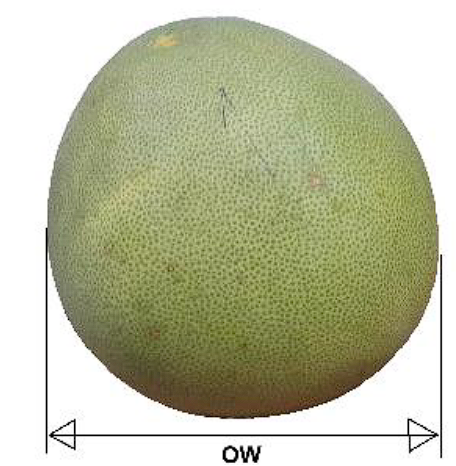Mass Modeling of Thailand Varieties Pomelo Fruit (Khao-Nampueng Variety) with Overall Width
doi: 10.14456/mijet.2022.37
Keywords:
Modeling, Classification, Grading, Pomelo mass, Pomelo widthAbstract
Thailand has exported fresh pomelo fruits to its neighbor country. However, many lack knowledge of the physical characteristics of the important pomelo variety. That is necessary for the design and classification of the grading system. Generally, in the pomelo market, the pomelo fruits are graded according to their size, shape and variety. Usually, fruits are graded based on size observation such as No.1, No.2, No.3 and No.4 while based on whether fruits are properly mature. Manual grading with labor is a common method that pomelo growers graded when they harvest the fruits. This study aimed to find the most suitable model for estimating the pomelo fruit mass of Thailand especially the Khao-Nampueng variety with its physical characteristics. There are not specific studies that have investigated the mass modeling of this fruit variety yet.
The results recommended that the mass model for overall fruits based on overall pomelo fruit width was the quadratic model: M = -1.2659X2 + 221.2X - 1824.1 with R² = 0.8856. While the mass model for fruit without peel based on overall pomelo fruit width was also a quadratic model: M = -13.216X2 + 496.38X – 3701.1 with R² = 0.7175. The predicted models can be useful for the design and classification of grading mechanisms for the Khao-Nampueng variety as the primary measurement before sending them to the market and transportation.
References
S. Kongsri, and P. Nartvaranant, "Fruit morphological characteristics and fruit quality of pomelo cv. Tabtim Siam grown in Nakhon Pathom and Nakhon Si Thammarat Provinces," Interdisciplinary Research Review, 14(1), 2019, pp. 5–11.
Research Center for Major Crop Production Development in Nakhon Pathom. "Pomelo in Nakhon Chaisri", Jan.14, 2018. Available:http://dept.npru.ac.th/agridvnp/index.php?act=6a992d5529f459a44fee58c733255e86&lntype=editor_left&slm_id=2248. [Accessed: May. 19, 2022].
N. N. Mohsenin, Physical Properties of Plant and Animal Materials., Second revised. Gordon and Breach Sci. Publ., New York, 1986.
K. Peleg, Produce Handling, Packaging and Distribution. The AVI Publishing Company, Inc., Westport, Connecticut., 1985, pp. 20–90.
O. Kleynen, V. Leemans and M. F. Destain, "Selection of the most effective wavelength bands for ‘Jonagold’ apple sorting," Postharvest Biology and Technology, vol.30, 2003, pp. 221-232.
G. Polder, G. W. A. M. van der Heijden and I. T. Young, "Tomato sorting using independent component analysis on spectral images," Real-Time Imaging, vol. 9, 2003, pp. 253-259.
F. Khoshnam, A. Tabatabaeefar, M. Ghasemi Varnamkhasti and A. M. Borghei, "Mass modeling of pomegranate (Punica granatum L.) fruit with some physical characteristics," Scientia Horticulturae, vol. 114, 2007, pp. 21–26.
E. Seyedabadia, M. Khojastehpourb, H. Sadrniab and M.H. Saiediradc. "Mass modeling of cantaloupe based on geometric attributes: A case study for Tile Magasi and Tile Shahri," Scientia Horticulturae, vol. 130, 2011, pp. 54-59.
F. Keshavarzpour and M. Rashidi. "Prediction of Apple Mass Based on Some Geometrical Properties Using Linear Regression Models," Academic Journal of Plant Sciences, vol. 4 , no. 4, 2011, pp. 118-123.
F. Shahbazi and S. Rahmati. "Correlation the mass of grapefruit to some physical attributes," Journal of Agroalimentary Processes and Technologies, vol. 19, no. 1, 2013, pp. 43-47.
F. Shahbazi and S. Rahmati. "Mass modeling of persimmon fruit with some physical characteristics," Agric Eng Int: CIGR Journal, vol. 16, no. 1, 2014, pp. 289-293.
K Sivabalan, CK Sunil and N Venkatachalapathy. 2019. "Mass modeling of coconut (Cocos nucifera L.) with physical characteristics," International Journal of Chemical Studies; vol. 7, no. 3, 2019, pp. 5067-5072.
M. Rashidi, S. Behboodi and H. B. Asl. "Modeling of Egg Mass Based on Geometrical Attributes," American-Eurasian Journal of Scientific Research, vol. 15, no. 1, 2012, pp. 39-45.
F. Shahbazi and S. Rahmati, "Mass modeling of fig (Ficus carica L.) fruit with some physical characteristics" Food Science and Nutrition, vol. 1, no. 2, 2013, pp. 125-129.
R. Stroshine, Physical properties of agricultural materials and food products, Course Manual. Purdue Univ., USA, 1998.
B. N. Salihah, S. Rosnah, and A. A. Norashikin. "Mass modeling of Malaysian varieties Pomelo fruit (Citrus Grandis L.Osbeck) with some physical characteristics," International Food Research Journal, vol. 22, no. 2, 2015, pp. 488-493.

Downloads
Published
How to Cite
Issue
Section
License

This work is licensed under a Creative Commons Attribution-NonCommercial-NoDerivatives 4.0 International License.








